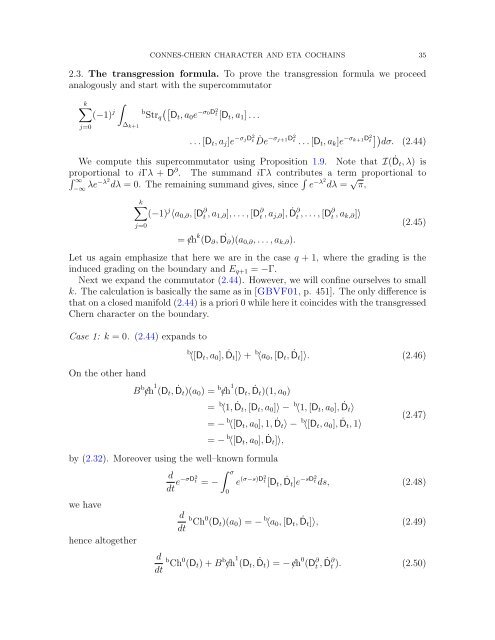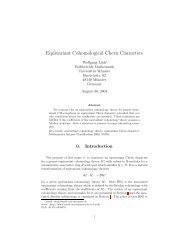Connes-Chern Character for Manifolds with Boundary and ETA ...
Connes-Chern Character for Manifolds with Boundary and ETA ...
Connes-Chern Character for Manifolds with Boundary and ETA ...
You also want an ePaper? Increase the reach of your titles
YUMPU automatically turns print PDFs into web optimized ePapers that Google loves.
CONNES-CHERN CHARACTER AND <strong>ETA</strong> COCHAINS 35<br />
2.3. The transgression <strong>for</strong>mula. To prove the transgression <strong>for</strong>mula we proceed<br />
analogously <strong>and</strong> start <strong>with</strong> the supercommutator<br />
k∑<br />
([<br />
(−1)<br />
∫∆ j b Str q Dt , a 0 e −σ 0D 2 t [Dt , a 1 ] . . .<br />
k+1<br />
j=0<br />
. . . [D t , a j ]e −σ jD 2 t Ḋe −σ j+1D 2 t . . . [Dt , a k ]e −σ k+1D 2 t<br />
])<br />
dσ. (2.44)<br />
We compute this supercommutator using Proposition 1.9. Note that I(Ḋt, λ) is<br />
proportional ∫ to iΓλ + D ∂ . The summ<strong>and</strong> iΓλ contributes a term proportional to<br />
∞<br />
−∞ λe−λ2 dλ = 0. The remaining summ<strong>and</strong> gives, since ∫ e −λ2 dλ = √ π,<br />
k∑<br />
(−1) j 〈a 0,∂ , [D ∂ t , a 1,∂ ], . . . , [D ∂ t , a j,∂ ], Ḋ∂ t , . . . , [D ∂ t , a k,∂ ]〉<br />
j=0<br />
= /ch k (D ∂ , ˙ D ∂ )(a 0,∂ , . . . , a k,∂ ).<br />
(2.45)<br />
Let us again emphasize that here we are in the case q + 1, where the grading is the<br />
induced grading on the boundary <strong>and</strong> E q+1 = −Γ.<br />
Next we exp<strong>and</strong> the commutator (2.44). However, we will confine ourselves to small<br />
k. The calculation is basically the same as in [GBVF01, p. 451]. The only difference is<br />
that on a closed manifold (2.44) is a priori 0 while here it coincides <strong>with</strong> the transgressed<br />
<strong>Chern</strong> character on the boundary.<br />
Case 1: k = 0. (2.44) exp<strong>and</strong>s to<br />
On the other h<strong>and</strong><br />
b 〈[D t , a 0 ], Ḋt]〉 + b 〈a 0 , [D t , Ḋt]〉. (2.46)<br />
B b /ch 1 (D t , Ḋt)(a 0 ) = b /ch 1 (D t , Ḋt)(1, a 0 )<br />
= b 〈1, Ḋt, [D t , a 0 ]〉 − b 〈1, [D t , a 0 ], Ḋt〉<br />
= − b 〈[D t , a 0 ], 1, Ḋt〉 − b 〈[D t , a 0 ], Ḋt, 1〉<br />
= − b 〈[D t , a 0 ], Ḋt]〉,<br />
(2.47)<br />
by (2.32). Moreover using the well–known <strong>for</strong>mula<br />
we have<br />
hence altogether<br />
d<br />
dt e−σD2 t<br />
∫ σ<br />
= − e (σ−s)D2 t [Dt , Ḋt]e −sD2 t ds, (2.48)<br />
0<br />
d b Ch 0 (D t )(a 0 ) = − b 〈a 0 , [D t ,<br />
dt<br />
Ḋt]〉, (2.49)<br />
d b Ch 0 (D t ) + B b /ch 1 (D t ,<br />
dt<br />
Ḋt) = − /ch 0 (D ∂ t , Ḋ∂ t ). (2.50)

















